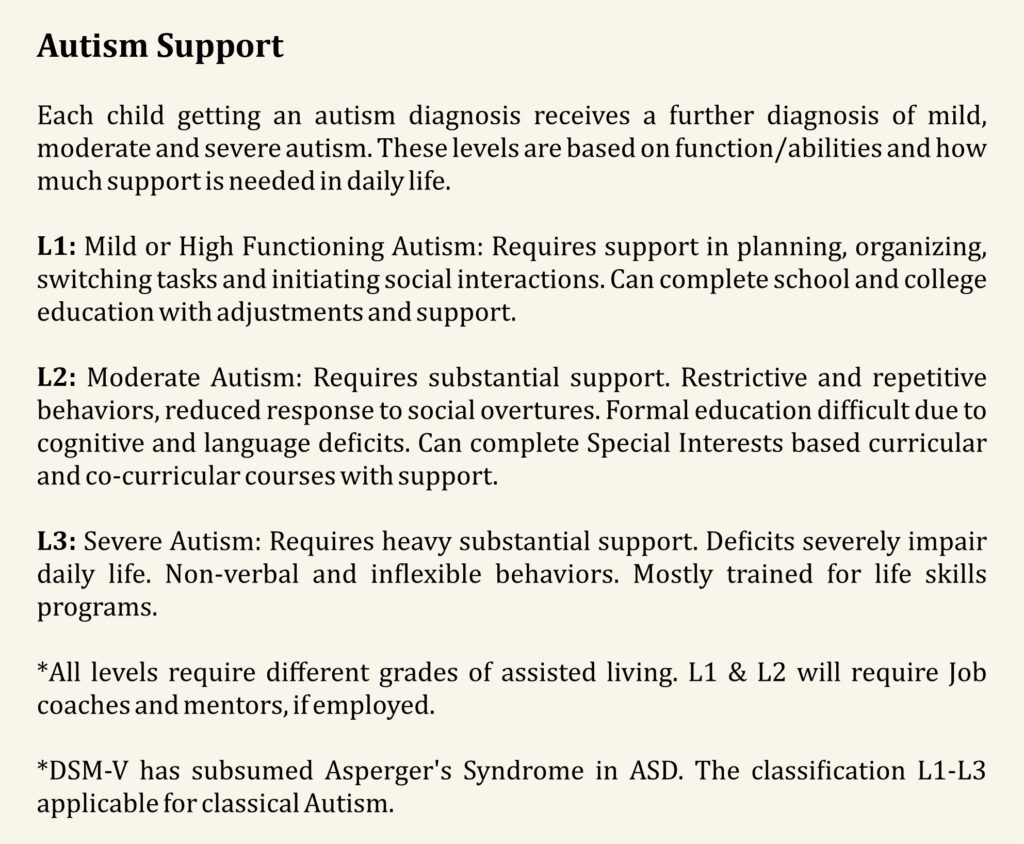Home is our personal sanctuary, the physical manifestation of our culture, values, needs, aspirations, a place where we treasure memories and create more. This is what usually a home is for most people and off the stack designs and options are chosen from. However, for autism families, many layers are added over what is usual.
When developing or renting a residence, autism families will benefit from a lifestyle sensibilities conscious approach, one that is premised on the needs and challenges of autism. While choosing to rent or construct a house or apartment, the headlining elements are to look for ideas that reduce distraction and over-stimulation, avoid stress and anxiety induced by sensory concerns and have formats that promote visual connectivity and assurance. Parents will do well to remember that all educational programs for individuals with autism depend on consistency, repetition, and structure.
As a general rule design elements that incorporate sensory and function-based spaces are harbingers of wellbeing. There are so many factors to consider when dealing with designing for those with neurological conditions. You could walk into an architecture environment with an exceptionally patterned flooring and your child could get into his stims just looking at it or have a meltdown, or worse still if the child has co-occurring epilepsy, it could prompt a seizure. The same applies to choice of wallpaper, upholstery, bed furnishings et al. However, the form over fashion rule does not mean it cannot be paired with sophistication.
Structural integrity creates levels of comfort
From a layout perspective, complicated hallways, maze, labyrinthine twisted spaces, tight corridors are strictly undesirable. The navigational strategy will benefit from being linear or curvilinear, so that blind corners are avoided, there is spatial continuity and autistics can see what lies ahead. This also reduces the risk of injury if the child is hyperactive. Spatial continuity and clear wayfinding are the watchwords. Always remember that environments must be easy to understand because autistic children and adults struggle processing sensory information from the environment and this can lead to frustration and erratic behavior. An open layout with different spaces given designated functions has immense benefits.
Achieving harmony between built environment and needs is crucial. The residence floor plan should create moments of discovery, variety and predictability. Even routine activities can be made elegant, its how you choose to elevate them. Parents who manage to create a harmonious blend between external and interior spaces, stick to simple designs and clear lines, avoid congestion and clutter, plant native vegetation, use natural tactile materials to dress up spaces with intuitive crafts that connect with nature’s rhythms; they integrate indulgence with tranquility. They take their child on a sensory journey and curate storytelling with visual impact. They build homes that are conscious and emotionally durable.
Hierarchy of spaces
A family’s composition and behavioral patterns dictates the placement of rooms and its site plan. Form and function go hand in hand that is the core, decorative flourishes come later. While thinking of your home, conversations, and brainstorming have to go into the child’s profile. Go for aesthetically simple, functionally robust, need-based range of features that are easy to install. How is the circulation of spaces? Define its importance based on activity, intensity and frequency of usage.
Spaces like the drawing room, dining and family lounges that center social life, leisure, recreation and conversation should be non-competitive and stress free. For the autistic child, these spaces are opportunities to practice appropriate movement and social interaction at the same time. If you do not have a study, consider setting up multi-functional desks and seating that can double up for educational purposes. These are the areas for bodily and ‘mentalization’ activities for your child.
The bedroom should be sleep inducing with adjusted lighting that is dimmable. Lighting in various parts of the house and different hours is a major concern. Research reports that many children are vulnerable to sub-visible flicker, and it can cause headaches, eyestrain, and increased repetitive behavior. A healthy lighting setup is one, which has a cheerful amount of brightness, not too harsh or too dim. There are many smart lighting options available now controllable from your phone with features of integrated lighting, switch off-on and adjustments all with a finger swipe and the concerned manufacturer app.
Most of our autistic children struggle with sleep. The last thing they need is a stimulated environment. Therefore, no work structures in the bedroom or screens.
Child centered architecture importantly involves well-placed windows at a height that are safe, direct natural light while at the same time shuttering of traffic noise. Daylighting aids cognitive abilities and improves health at the same time sunshading is equally important.
Consider windows with louvres for natural light. If you have a preference for natural materials, consider bamboo mat blinds.
Sights, acoustics and textures have to be employed to reflect balance. For example, to remove distractions, limiting or eliminating external views or subduing daylight cannot be a pervasive rule. If some spaces open to a garden or foliage draped street view, plenty of views to the outside may just be what is needed for an immersive teaching experience. Consider floor to ceiling windows with in-built safety to augment the panoramic view. Benches on balconies, garden side lets autistics learn through observing. The amount and type of visual stimulation has to be well thought out.
Structural and interior designs must serve functional requirements and improve educational performance and living etiquettes. The sensory definition of autism is vital when designing. Good architects always design with tactile and visual sensations – it’s a great way to engage all the senses, eye, hand and mind. Designing sensory heavens for residences does not mean doing replicas of therapy centers and schools rather they should mimic neurotypical environments but with autism friendly lighting, colors, sounds and spatial volumes.
Have open to sky spaces in your residence even if it is only a small balcony it should deliver a miniature landscape experience. If you have large verandas, consider arches or squares.
Overall principle should be to organize spaces based on stimulus levels with transition zones from high to low. This is called sensory zoning. It serves multiple purposes – spatial sequencing and compartmentalization, visually clear orientation and function separation. The extroverted spaces will have a different gradient from the introverted ones with reference to layout, entrances, light and acoustics.

ADLs & Bathrooms
The bathroom must be designed as a wellness suite and personal sanctuary. Most autistic children struggle with self-care rituals, well into teens and some even beyond – a reason why it is taught as a subject called Activities of Daily Living or ADLs.
Residences are perfect settings for parents to equip their children in this field and double up on what is taught in school. Here again, use simple design with straight lines. Have a separate walk-in with closets attached with the bathroom, so that the child learns the chore of undressing, dressing, stacking his clothes for laundry. The bathroom should have a pristine spa like ambience allowing for engagement and use. Since the autistic brain loves structure and method the toileting and bath spaces must be clearly demarcated with partitions of glass, wood or any other natural material. This way motor skills for ADLs can be developed faster with visual feedback.
Furniture
Furniture choices reflect one’s identity and personal growth; it is a storyteller. It also beams sensory feedback and therefore is a harness for therapeutic activities. Hence it must be researched for shapes, fabrics and material. The one golden rule for safety is to avoid sharp edges. Furniture should be purposive, durable and sustainable.
Aesthetics and comfort woven into design is a tagline worth chasing. A good hack for saving time and research is to begin by listing your child’s preferences, aversions, routines, rituals and fixations. It can be incredibly powerful. And then you combine sensory sensitive and neurotypical approaches with spatial considerations. For example, you could choose geometrical layouts with modular features or clean lined furniture.

Nature- centric philosophy, nature-first ethos
Grow a garden. Plants generate visual and auditory feedback. Label the plants – herbs, grass and variety of rocks for texture. Have variegated sections, organized in a discernable order. Incase of a large courtyard or verandah the landscaping can be a continuous theme blurring the lines between the outdoors and indoors.
Sync the garden with the kitchen. Gardens aren’t just for yards or parks. They can also flourish on balconies, rooftops, and vertical spaces. By using containers filled with potting media, people can grow food almost anywhere and garden organically. Herbs, roots, stems, greens, seasonal plants in a kitchen garden are a wonderful way of creating connection with food. Also, both – the garden and the kitchen – are sensory testbeds and sites of kinesiology. If you can improve the child’s motor skills working in the garden or helping out in the kitchen, there is a correlation for creating opportunities of social interactions and learning sequential tasks. For kids on the autism spectrum, observing and appropriately responding to social cues is often a challenge, these interactive moments form circles of communication in an organic manner in everyday life and create the basis for recharge, reset and mindful relaxation.
Houses should not be only about built forms; it has to nestle landscaping a coming together of manmade and natural beauty.
Conclusion
Vision of modern luxury is creating unique experiences in everyday living. Of course, fresh thinking and embracing new techniques and concepts are tough but once done the Quality-of-Life rewards are many. It is easy to stagnate into standard styles, but the cost is heavy.
Architectural designs need to be predictable, clear, and simple, address the challenges of orientation/motor skills, stereotyped movements, sensory balance, hypo or hyperactivity to sensory inputs, propensities of routine and ritual.
An overload of stimuli and unpredictability are typical triggers that cause stress and anxiety. An accessible and easy oriented environment increases the possibilities for life qualities and function. The physical environment must reduce stress, support independence and being social in different manners.
Ultimately, it’s the child’s needs psychology that must layer the architecture. Build a home that has spaces as resonant metaphors for happy order, cleanliness, calm mindfulness and intentional living.
Postscript: To parents, I say break down the barriers of limitations and challenges. Learning can happen through task like therapy activities, special education sessions and also by minimizing the task-oriented nature by getting work itself into a daily rhythm. That’s where Architecture becomes important because it is one of the few design mediums that requires full physical interaction. Creating responsive, sensory environments, physical spaces that support increased mind-body connection, helps develop skills, expand social interaction and is a powerful tool for the autistic way of life.
Disclaimer: The opinions and views expressed in this article/column are those of the author(s) and do not necessarily reflect the views or positions of South Asian Herald.


![Autism Spectrum[1].jpg](https://southasianherald.com/wp-content/uploads/2025/03/Autism-Spectrum1.jpg-1170x775.jpeg)



